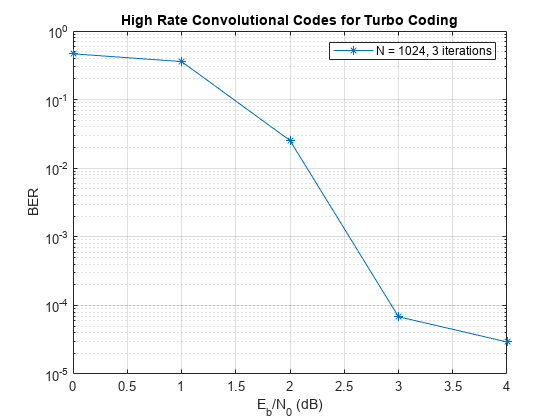comm.ConvolutionalEncoder
Convolutionally encode binary data
Description
The comm.ConvolutionalEncoder
System object™ encodes a sequence of binary input vectors to produce a sequence of binary
output vectors.
To convolutionally encode binary data:
Create the
comm.ConvolutionalEncoderobject and set its properties.Call the object with arguments, as if it were a function.
To learn more about how System objects work, see What Are System Objects?
Creation
Syntax
Description
convencoder = comm.ConvolutionalEncoder
convencoder = comm.ConvolutionalEncoder(trellis)TrellisStructure property to trellis.
convencoder = comm.ConvolutionalEncoder(___,Name=Value)comm.ConvolutionalEncoder(TerminationMethod='Continuous') specifies
the termination method as continuous to retain the encoder states at the end of each input
vector for use with the next input vector.
Properties
Usage
Syntax
Description
codeword = convencoder(message)codeword is the encoded codeword.
message and codeword are column vectors of
numeric, logical, or unsigned fixed-point values with word length 1 (fi (Fixed-Point
Designer) object).
codeword = convencoder(message,initstate)TerminationMethod property to 'Truncated' and the
InitialStateInputPort property to 1
(true).
codeword = convencoder(message,resetstate)TerminationMethod property to 'Continuous' and the
ResetInputPort
property to 1 (true).
[
also returns the final state of the encoder. To enable this syntax, set the codeword,finalstate] = convencoder(message)FinalStateOutputPort property to 1
(true) and the TerminationMethod property to 'Continuous' or
'Truncated'.
Input Arguments
Output Arguments
Object Functions
To use an object function, specify the
System object as the first input argument. For
example, to release system resources of a System object named obj, use
this syntax:
release(obj)
Examples
More About
References
[1] Clark, George C., and J. Bibb Cain. Error-Correction Coding for Digital Communications. Applications of Communications Theory. New York: Plenum Press, 1981.
[2] Gitlin, Richard D., Jeremiah F. Hayes, and Stephen B. Weinstein. Data Communications Principles. Applications of Communications Theory. New York: Plenum Press, 1992.
[3] Yasuda, Y., K. Kashiki, and Y. Hirata. “High-Rate Punctured Convolutional Codes for Soft Decision Viterbi Decoding.” IEEE® Transactions on Communications 32, no. 3 (March 1984): 315–19. https://doi.org/10.1109/TCOM.1984.1096047.
[4] Haccoun, D., and G. Begin. “High-Rate Punctured Convolutional Codes for Viterbi and Sequential Decoding.” IEEE Transactions on Communications 37, no. 11 (November 1989): 1113–25. https://doi.org/10.1109/26.46505.
[5] Begin, G., D. Haccoun, and C. Paquin. “Further Results on High-Rate Punctured Convolutional Codes for Viterbi and Sequential Decoding.” IEEE Transactions on Communications 38, no. 11 (November 1990): 1922–28. https://doi.org/10.1109/26.61470.
[6] Moision, B. "A Truncation Depth Rule of Thumb for Convolutional Codes." In Information Theory and Applications Workshop (January 27 2008-February 1 2008, San Diego, California), 555-557. New York: IEEE, 2008.
Extended Capabilities
Version History
Introduced in R2012a
